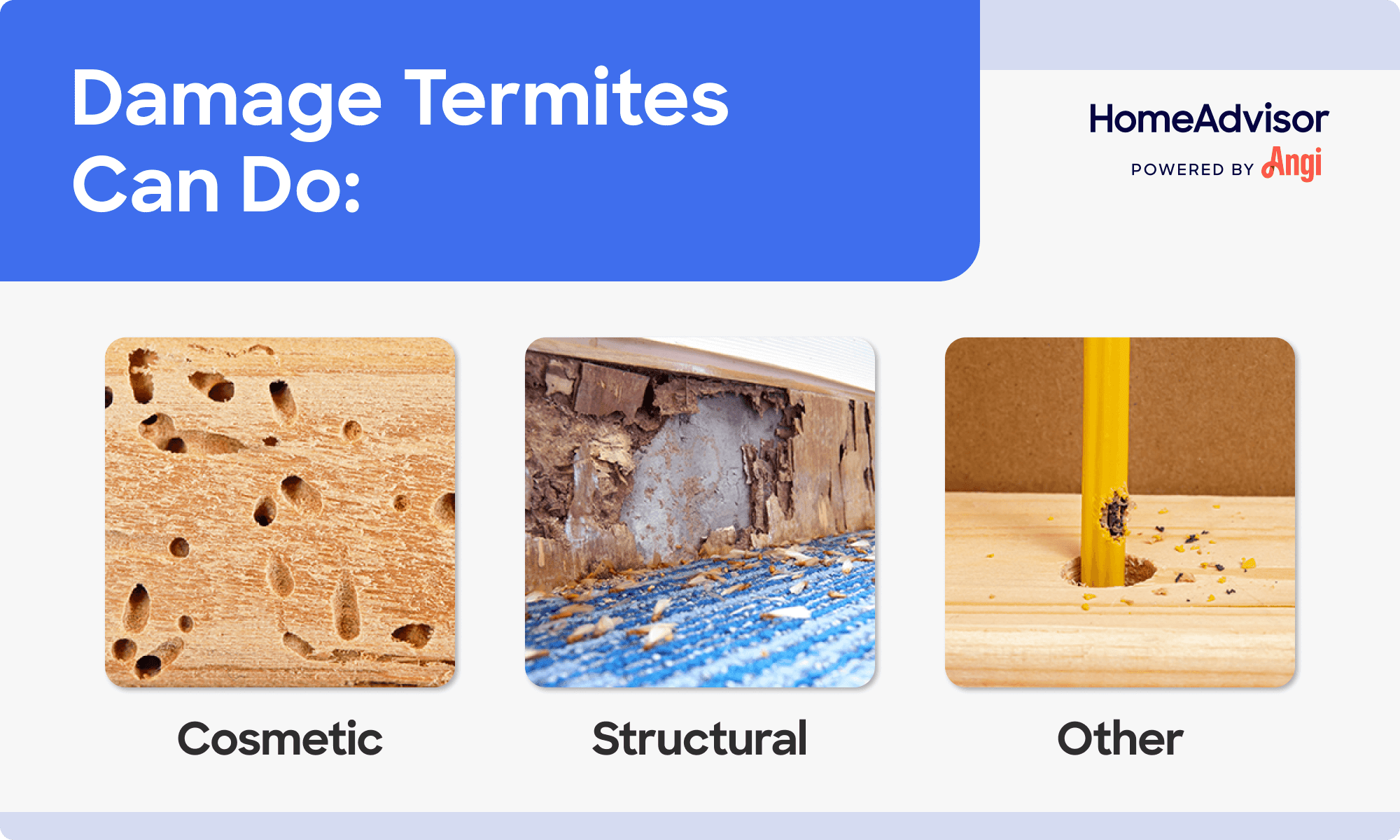
Budget for termite treatment costs based on factors such as termite type, infestation size, inspections, treatment type, labor, and more.


A termite inspection costs anywhere from $75 to $325, with an average price of $100.
Many pest-control companies offer complimentary inspections, especially when they hope to earn your business for treatment.
Inspection costs vary by property size, infestation severity, and location.
Costs also vary depending on the reports and clearance letters you receive.
This article was updated using automation technology and thoroughly reviewed for accuracy by HomeAdvisor Editor Ryan Noonan.
Termite inspection is essential for keeping your property safe. The average termite inspection cost is $100, with most prices averaging between $75 and $325. Work these costs into your annual home maintenance budget and call a trusted termite professional at the first sign of trouble to avoid costly structural repairs.
The total termite inspection cost might include the inspection itself and a termite letter confirming the inspection to a home lender. When buying or selling a home, you may need to pay for a required termite inspection in addition to a regular home inspection. Homeowners who aren’t listing their homes should get a termite inspection once every one to two years.

The cost of a termite inspection depends on a variety of factors. Here’s a closer look at how your total breaks down.
The termite inspection is only part of the cost of remediating these pests. If a termite infestation is detected, plan to spend between $230 and $1,000 on an average treatment. In cases of extensive infestations requiring fumigation, costs can range from $1,500 to $8,000.
The larger and more complex your home is, the more you’ll need to pay for a termite inspection. This is simply because it will take longer for your termite control pro to complete their inspection. On the other hand, if you live in a small home with fewer floors, you can expect to pay lower costs for a professional termite inspection.
Larger infestations require more time to inspect, resulting in increased costs for homeowners. An inspection of a small infestation in one isolated area can cost as little as $75, while extensive infestations spread throughout the entire home can cost as much as $325, excluding extermination costs.
Many pest inspectors waive the fee for annual termite inspections. If they don’t find anything, you won’t have any costs. If they do find an infestation, you’ll have to pay for treatment and may also need to pay to repair the damage they’ve done. For example, you might need to budget up to $2,350 for the cost of repairing carpentry framing.
While annual termite inspections are often free, you’ll pay a fee for a one-time inspection when it’s required with a house sale, especially if your lender requires a termite letter.
Location can also impact overall costs. Areas known for high termite activity, such as South Carolina, may be more expensive because termite extermination services are in higher demand. In addition, location can affect local labor rates; if you live in an area with a higher cost of living, expect your termite inspection cost to match.
If you’re not in the middle of a real estate deal, many pest control companies waive the inspection fee during an annual check. Such contractors are hoping that, if they find signs of termite damage, you’ll hire them to handle the treatment.
You should get a free termite inspection at least once every two years. In areas with a high probability of infestation, get one annually.
When included as part of a bundled home inspection package, termite inspections contribute to a total cost ranging between $250 and $400.
Some lenders may require a termite clearance letter or official report that confirms a professional conducted a termite inspection and that no termites were found (or that, if found, they were eradicated). If you need such a letter for the sale or insurance purposes, you’ll spend $100 to $200 on top of the cost of insect treatment.
Some lenders go a step beyond the termite letter. If the inspector discovers termites during a home inspection before the sale of a home, your lender may require you (as the buyer) to purchase a termite bond agreement. This agreement outlines how you’ll treat the termites and prevent them from returning. These agreements can cost anywhere from $500 to $2,000.
South Carolina requires a CL-100 South Carolina Wood Infestation Report with all real estate transactions. It's the official name of a termite report and will cost the same as a letter in other states, or CL-100 Inspection: $160 on average. However, unlike in other states, these letters are only valid for 30 days after the inspection date. CL-100 expenses can either be part of the closing costs or paid for by the homeowner.
There are approximately 45 distinct species of wood-destroying organisms in the United States. They all fall into one of three categories: Subterranean, drywood, or dampwood.
Subterraneans need to have contact with the soil and build mud tunnels onto the wood from underground nests.
Drywoods live in wood with a low moisture content and don't require contact with the soil. They live in dry climates or areas with older homes where the wood has completely cured.
Dampwoods do not require soil contact, but they need wood with a higher moisture content. They love humid areas or new construction.
In addition to termites, a CL-100 report—and other new home purchase WDO inspections—look for old house borers, powder post beetles, and damage caused by other insects, such as carpenter ants. Ant exterminators cost between $80 and $500, should you need to hire one.
It costs $50 to $150 for Veterans Administration inspections. The VA requires one in areas with a “very heavy” or “moderate-to-heavy” infestation probability, according to the Termite Infestation Probability Map. For condominiums, a pest inspection is only required if the property appraiser identifies a potential issue. Property appraisers cost between $315 and $420.
There’s no substitute for termite remediation if you end up having an infestation, but there are a few ways to reduce the cost of both the inspection and the treatment itself. These include:
Ensure all areas to be inspected are clear of debris, furniture, and outdoor plants to minimize labor costs.
See if you can negotiate free or low-cost termite inspections with annual inspection and treatment plans.
If you’re getting a termite inspection as a homebuyer, negotiate with your seller or lender to have them pay for it.
If you’re a veteran, look into state regulations to see if you qualify for free termite inspections.
If you have an infestation, opt for lower-cost treatments when possible—many infestations can be addressed with inexpensive termiticide or bait stations rather than fumigation or heat treatment.
No place is more important than your home, which is why HomeAdvisor connects homeowners with local pros to transform their houses into homes they love. To help homeowners prepare for their next project, HomeAdvisor provides readers with accurate cost data and follows strict editorial guidelines. After a project is complete, we survey real customers about the costs to develop the pricing data you see, so you can make the best decisions for you and your home. We pair this data with research from reputable sources, including the U.S. Bureau of Labor Statistics, academic journals, market studies, and interviews with industry experts—all to ensure our prices reflect real-world projects.
From average costs to expert advice, get all the answers you need to get your job done.

Budget for termite treatment costs based on factors such as termite type, infestation size, inspections, treatment type, labor, and more.

Who to call for skunk removal? Learn when to hire animal control or pest control, safety tips, and skunk removal cost before you book

Who to call for wildlife removal? Learn when to hire wildlife removal specialists or animal control and how pros safely handle critters

Who to call for a cat stuck in a tree? Call an arborist, not 911. Learn why an arborist beats animal control and how rescues work

earn who to call for fox removal—wildlife removal service or animal control—plus costs, safety, and steps so you can choose the right help.